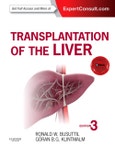"They have, in fact, succeeded in raising the bar yet again and making their work product even better in the third edition of Transplantation of the Liver." Forewords by, Thomas E. Starzl, June 2015
- Access valuable pearls, pitfalls, and insights from Dr. Ronald Busuttil and Dr. Goran Klintmalm, two of the world's preeminent experts in liver surgery. - Understand today's full range of transplantation techniques with complete step-by-step descriptions of each, and access the background information and management options for each hepatic disease entity. - Take advantage of detailed discussions of everything from pathophysiology and patient and donor selection, to transplantation anesthesia and operative procedures; immunosuppression; postoperative care; and ethical issues. - Overcome your toughest challenges in liver transplantation. Many new and thoroughly revised chapters include: Deceased Organ Donation after Cardiac and Brain Death; Liver Transplantation for Non-Alcoholic Steatohepatitis; Extended Criteria Donors; Best Techniques for Biliary and Vascular Reconstruction in Living Donor Transplantation; Small for Size Syndrome; Dual Grafts for Transplantation; Arterial Reconstructions-Pitfalls; Transition of Pediatric Patients to Adulthood; Immunosuppressive Biologic Agents; Long Term Toxicity of Immunosuppressive Therapy; Stem Cell and Liver Regeneration; and Extracorporeal Perfusion for Resuscitation of Marginal Grafts. - Stay current in your field and optimize patient outcomes with coverage of the most recent advances in living donor transplantation, pediatric transplantation, and gene and stem cell therapy. - Access the latest information on anti-rejection/immunosuppressive drugs, as well as comprehensive discussions of each drug or combination of drugs used to suppress immune system. - Effortlessly search the entire text online at Expert Consult.
With 104 additional contributing experts
Table of Contents
I: General Considerations
1. History of Liver Transplantation
2. Surgical Anatomy of the Liver
3. Molecular and Cellular Basics of Liver Failure
4. Influence of Transplantation on Liver Surgery
5. Organ Allocation: The US Model
6. Organ Allocation: The European Models
7. Donation After Cardiac or Brain Death: Regulatory and Ethical Principles
II: Patient Evaluation: Adult
8. Current Indications, Contraindications, Delisting Criteria, and Timing for Transplantation
9. Transplantation for Hepatitis A and B
10. Natural History of Hepatitis C
11. Transplantation for Hepatitis C
12. Transplantation for Fulminant Hepatic Failure
13. Transplantation for Primary Biliary Cirrhosis
14. Transplantation for Sclerosing Cholangitis
15. Transplantation for Autoimmune Hepatitis
16. Transplantation for Primary Hepatic Malignancy
17. Transplantation for Cholangiocarcinoma
18. Transplantation for Metastases
19. Transplantation for Hematological Disorders
20. Transplantation for Budd-Chiari Syndrome
21. Transplantation for Alcoholic Liver Disease
22. Transplantation for Nonalcoholic Steatohepatitis
23. Unusual Indications for Transplantation
III: Patient Evaluation: Pediatric
24. General Criteria for Transplantation in Children
25. Transplantation for Cholestatic Liver Disease in Children
26. Transplantation for Biliary Atresia in Children
27. Transplantation for Metabolic Disease in Children
28. Transplantation for Hepatic Malignancy in Children
IV: Special Considerations in Patient Evaluation
29. Ethical Decisions in Transplantation
30. Psychiatric Assessment of Liver Transplant Candidates
31. Pretransplantation Evaluation: Cardiac
32. Pretransplantation Evaluation: Renal
33. Pretransplantation Evaluation: Infectious Disease
34. Role of the Clinical Nurse Coordinator
35. Radiological Evaluation in Transplantation
36. Monitoring and Care
37. Nutritional Aspects of Transplantation in Adults
38. Management of Portal Hypertensive Hemorrhage
39. Portopulmonary Hypertension and Hepatopulmonary Syndrome
V: Operation
40. Donor Selection and Management
41. Extended Criteria Donors
42. Donating After Cardiac Death
43. The Donor Operation
44. Principles of Liver Preservation
45. Recipient Hepatectomy and Grafting
46. Anesthesia for Liver Transplantation
VI: Split and Living Donor Transplantation
47. Imaging Techniques for Partial Grafting
48. Living Donor Transplantation in Children
49. Living Donor Transplantation: Evaluation and Selection in Adults
50. Adult Living Donor Right Hepatectomy and Recipient Operation
51. Adult Living Donor Left Hepatectomy and Recipient Operation
52. Split Liver Transplantation for Pediatric and Adult Recipients
53. Split Liver Transplantation for Two Adult Recipients
54. Biliary and Vascular Reconstruction in Living Donor Transplantation
55. Small-for-Size Syndrome
56. Minimally Invasive Living Donor Hepatectomy
57. Dual Grafts for Transplantation
58. Outcomes of Living Donor Transplantation: The Western Perspective
59. Outcomes of Living Donor Transplantation: The Eastern Perspective
60. Ethics of Living Donor Transplantation
VII: Unusual Operative Problems
61. Arterial Reconstruction Pitfalls
62. Portal Vein Thrombosis and Other Venous Anomalies
63. Combined Liver-Kidney Transplantation
64. Retransplantation
65. Clinical Management of Necrotic Liver Before and After Transplantation
66. Intestinal and Multivisceral Transplantation
67. Transplantation: Situs Inversus and Polysplenia Syndrome
68. Auxiliary Transplantation
VIII: Postoperative Care
69. Postoperative Intensive Care Management in Adults
70. Postoperative Intensive Care Management in Children
71. Postoperative Management Beyond the Intensive Care Unit: Adults
72. Postoperative Care of Pediatric Transplant Recipients
73. Transition of Pediatric Patients to Adulthood
74. Renal Failure in Adults
75. Graft Failure
76. Technical Problems: Biliary
77. Arterial Complications after Transplantation
78. Infections After Transplantation
79. Recurrent Hepatitis C After Transplantation
80. Late Complications and Recurrence of Disease After Transplantation
81. Neuropsychiatric Complications
82. Neurological Complications
83. Role of the Posttransplantation Clinical Nurse Coordinator
IX: Transplant Pathology
84. Histopathology of Liver Transplantation
85. Pathology of NonNeoplastic Disease After Transplantation
86. Transplant-Related Malignancies
X: Immunology of Liver Transplantation
87. Rejection After Transplantation
88. Leukocyte Chimerism- Meaning and Consequences
89. ABO, Tissue Typing, and Crossmatching Incompatibility
90. Graft-Versus-Host Disease
XI: Immunosuppression
91. Induction and Maintenance of Immunosuppression
92. Special Considerations for Immunosuppression In Children
93. Treatment of Acute and Chronic Rejection
94. Novel Immunosuppression of Patients with Hepatic Malignancies
95. Novel Immunosuppressive Drugs
96. Immunosuppressive Biologic Agents
97. Long-term Toxicity of Immunosuppressive Therapy
XII: Survival and Results
98. Outcome Predictors in Transplantation
99. U.S. Trends in Transplantation
100. Long-term Functional Recovery and Quality of Life
101. Survival and Quality of Life in Children
XIII: Future Developments in Liver Transplantation
102. Genetic and Genomic Potentials in Liver Transplantation
103. Liver and Hepatocyte Xenotransplantation
104. Stem Cell and Liver Regeneration
105. Ischemia-Reperfusion Injury in Liver Transplantation
106. Extracorporeal Perfusion for Resuscitation of Marginal Grafts
107. Current Clinical Status of Extracorporeal Devices







